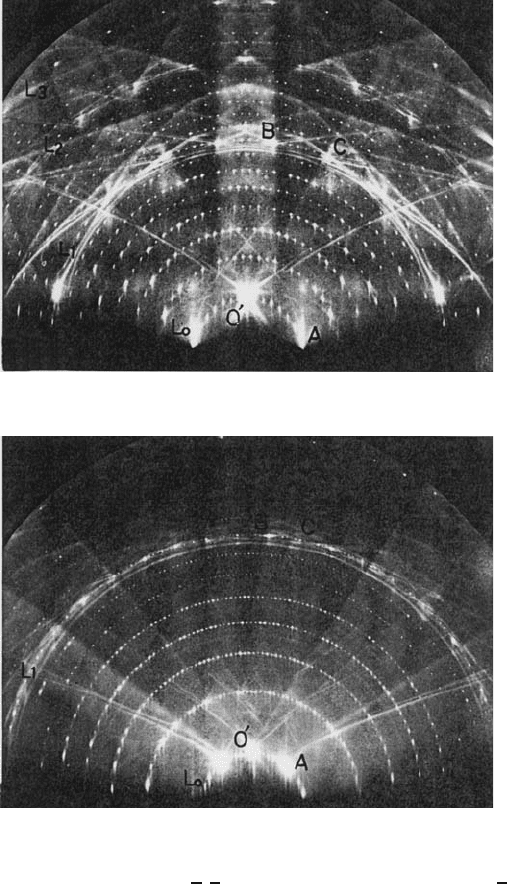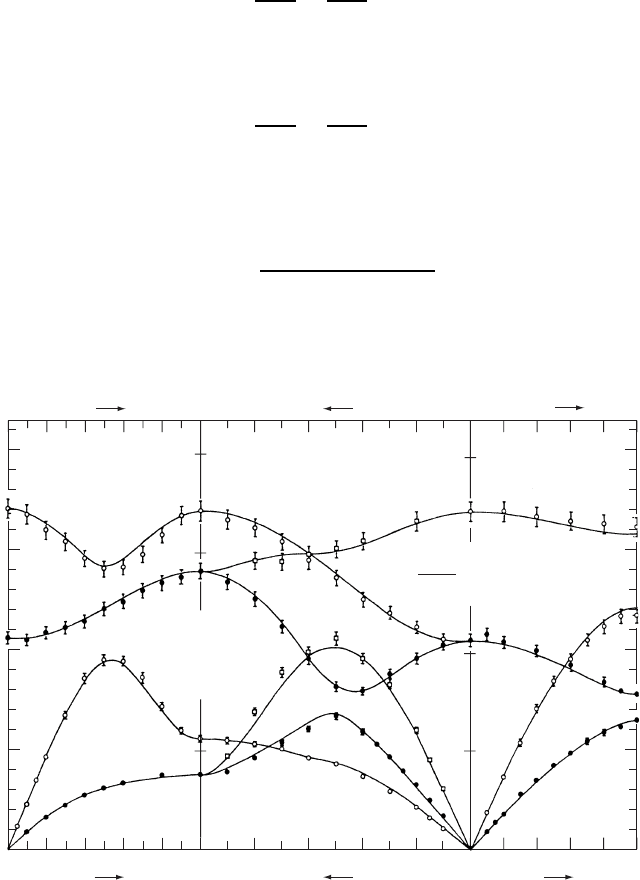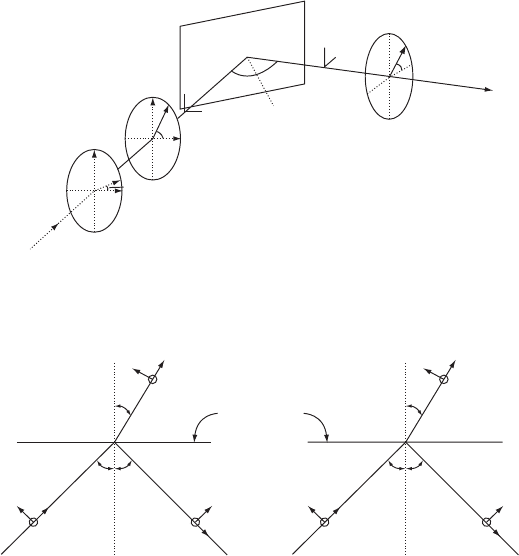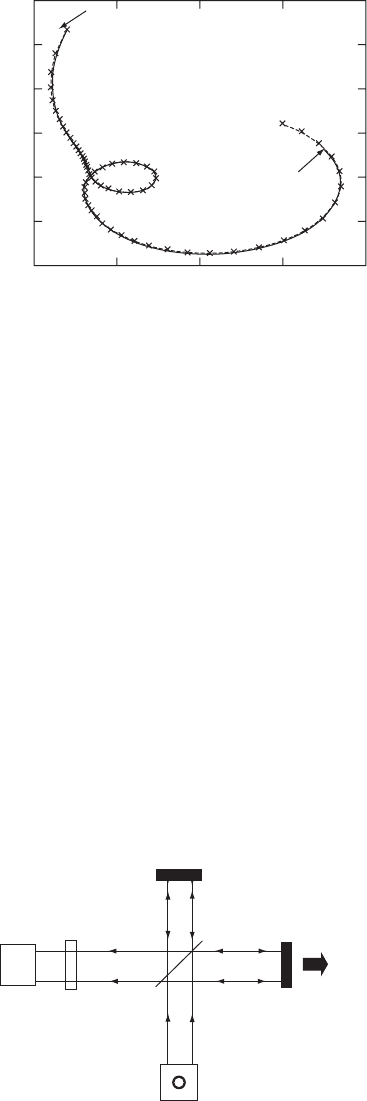Gersten J.I., Smith F.W. The Physics and Chemistry of Materials
Подождите немного. Документ загружается.


424 CHARACTERIZATION OF MATERIALS
(a)
(b)
Figure W22.5. RHEED patterns taken with 20-keV electrons from Si (111) with the 7 ð 7
structure. The upper pattern (a)isfor[
121] and the lower pattern (b)isfor[011] incidence.
[From S. Ino, Jpn. J. Appl. Phys., 16, 891(1977). Copyright 1977 by the Japanese Journal of
Applied Physics.]
Examples of RHEED patterns are given in Fig. W22.5. RHEED is used to monitor
atomic layer-by-layer thin-film growth in MBE. Oscillations of spot amplitudes yield
growth rates and provide information on the growth mode.
W22.5 Neutron Scattering
Neutron scattering involves directing a beam of neutrons from a nuclear reactor at
a solid and monitoring the scattered neutrons with a detector. There are both elastic

CHARACTERIZATION OF MATERIALS 425
and inelastic contributions. The elastic contribution produces a diffraction pattern and
provides useful structural information such as interatomic spacings and symmetries of
the crystal. Inelastic scattering provides information concerning the phonon spectrum
and magnons in magnetic materials. Neutrons scatter off the nuclei via the strong
interaction and off electrons by magnetic interactions. The cross sections are small,
on the order of several square fermis [(10
15
m)
2
], so the mean free path is long.
Therefore, information is obtained concerning the bulk sample. It makes a difference
whether the sample is magnetized or not, and neutron scattering is therefore a valuable
tool for probing the magnetic ordering of matter. Studies may be made as a function of
temperature, external magnetic field, pressure, stress, or other thermodynamic variables.
It provides a powerful tool for obtaining phase diagrams of materials.
The neutrons that emerge from the reactor are collimated into a narrow beam by
placing absorbing shields in all but the desired beam direction. For thermal neutrons
(T D 300 K) the mean wave-vector magnitude is k D 4.3 ð 10
10
m
1
. A monoener-
getic source is constructed from the thermal source by Bragg scattering the neutrons
off a crystal and further collimating the beam. By varying the angle of incidence the
neutron energy is tunable through some range of values. The typical wave vector is
several times greater than typical reciprocal lattice vectors G of samples to be studied.
Scattering from magnetized crystals can produce a polarized neutron beam.
The discussion begins by studying the case of neutron diffraction (i.e., elastic scat-
tering from the crystal). Suppose that the incident neutron wave vector is k and the
scattered wave vector is k
0
. The wave-vector transfer is
q D k
0
k.W22.36
If the lattice is periodic in three dimensions, momentum is conserved modulus a recip-
rocal lattice vector, implying that
q D G.W22.37
The energy conservation condition is
¯h
2
k
0
2
2M
n
D
¯h
2
k
2
2M
n
,W22.38
where M
n
is the neutron mass. It follows that
q D 2k sin
2
,W22.39
where is the scattering angle between vectors k and k
0
. The sample is rotated, and
whenever q D G is satisfied, a diffraction peak occurs. For single crystals the actual
value of the G vector is determined from the knowledge of k and k
0
.
As with x-ray diffraction, at finite temperatures the crystal may be regarded as an
admixture of ordered and disordered phases. The disordered part does not produce a
diffraction pattern but rather, produces a thermal diffuse background scattering. When
the crystal temperature is raised so that it finally melts, there is only diffuse scattering.
Additional contributions to the diffuse background are due to imperfections, impurities,
the magnetic moments of unaligned nuclei, and isotopic inhomogeneities.

426 CHARACTERIZATION OF MATERIALS
Inelastic neutron scattering is also possible. In this case one or more phonons or
magnons are either absorbed or emitted by the neutron in the course of scattering.
It is possible to measure the dispersion curve of these elementary excitations [i.e.,
to determine the dependence of their frequency ωQ on their wave vector Q]. For
absorption of a single phonon (or magnon) the conservation laws are
k
0
D k CQ C G,
¯h
2
k
0
2
2M
n
D
¯h
2
k
2
2M
n
C ¯hωQ. W22.40
The corresponding formulas for the emission of a single excitation are
k
0
D k Q C G,
¯h
2
k
0
2
2M
n
D
¯h
2
k
2
2M
n
¯hωQ. W22.41
Phonons and magnons are excitations that obey Bose–Einstein statistics. The number
of excitations in mode Q is given by the Bose –Einstein distribution function:
nQ,T D
1
exp[¯hωQ/k
B
T] 1
.W22.42
The relative contribution of occupied to unoccupied states should be in the ratio of the
Boltzmann factor, exp[¯hωQ/k
B
T]. One therefore expects to see a spectrum (called
ΓΓ
0 0.2
0
5
10
15
20
0.4 0.6 0.8 1.0 0.8 0.6 0.4 0.2 0 0.1 0.2 0.3 0.4 0.5
Phonon energy (meV)
z
[z00] [zz0] [zzz ]
∆
1
∆
Λ
1
Λ
3
Λ
1
Λ
3
∆
5
∆
1
∆
5
AgBr
4.4 K
Shell-Model-Fit
X Σ
Σ
1
Σ
1
Σ
3
Σ
4
Σ
4
Σ
3
Λ
L
Figure W22.6. Phonon dispersion curves for AgBr at T D 296 K measured by neutron scat-
tering. [From Y. Fujii et al, Phys. Rev. B, 15, 358 (1977). Copyright 1977 by the American
Physical Society.]

CHARACTERIZATION OF MATERIALS 427
the dynamical structure factor)oftheform
SQ,ω D e
2W
type,Q
j
MQ
j
2
[[nQ,TC 1]υω CωQ C nQ,Tυω ωQ],
W22.43
where M is a matrix element describing the coupling of the neutron to the particular
excitation and is defined in terms of the energy transfer:
¯hω D
¯h
2
k
0
2
2M
n
¯h
2
k
2
2M
n
.W22.44
The sum over “types” includes the various branches of the phonon spectrum (TA, LA,
TO, LO) as well as magnons, if they are present.
If the energy of the neutrons is sufficiently high, it is also possible to have emis-
sion or absorption of more than one elementary excitation. Thus two-phonon, three-
phonon,... processes are possible.
In summary, neutron scattering provides the means to measure the dispersion curves
of the low-energy elementary excitations of the crystal. An example of a set of such
curves is given in Fig. W22.6, where data for AgBr are presented along principal
symmetry directions of the reciprocal lattice.
OPTICAL SPECTROSCOPY
In the following sections various optical methods to acquire information about solids
are explored. First, optical spectroscopy is discussed for electromagnetic radiation in
the infrared, visible, and ultraviolet regions of the spectrum. The solid is excited from
its ground state to some excited state and information concerning such transitions
may be obtained from the reflectance or transmittance. This is followed by a discus-
sion of ellipsometry, which provides a technique for systematically mapping out the
electromagnetic properties of materials by examining the reflected light. The methods
of Fourier transform infrared spectroscopy and Raman spectroscopy provide comple-
mentary techniques for further characterizing the bulk of materials in the infrared.
Luminescence provides additional information about the excited states of the solid
as they relax toward lower-energy states by radiative emission. Finally, nonlinear
optical spectroscopy provides important information on how strong electromagnetic
fields interact with solids.
W22.6 Optical Spectroscopy in the Infrared, Visible, and Ultraviolet
The propagation of light through a material is governed by a complex index of
refraction Qnω D nω C i5ω. The real part of this index determines the speed of
propagation through the medium
v D
c
nω
.W22.45
The imaginary part determines the absorption coefficient that appears in the law of
attenuation, Beer’s law:
Ix
I
0
D exp[˛ωx].W22.46

428 CHARACTERIZATION OF MATERIALS
Here Ix/I
0
is the fraction of the initial light intensity entering the material that
remains after traversing a distance x and
˛ω D 2
ω
c
5ω. W22.47
One of the central goals of solid-state physics over the years has been to try to explain
the optical properties of materials in terms of the response of the electrons and the
lattice.
The index of refraction is measured directly using a reflectance apparatus. The
reflection coefficient, R, is the ratio of the reflected intensity to the incident intensity
and is given, for the case of normal incidence on a thick sample [see Eq. (8.16)], by
Rω D
[nω 1]
2
C [5ω]
2
[nω C 1]
2
C [5ω]
2
W22.48
(For thin samples the expression is more complicated due to interference effects caused
by reflection from the back surface of the film.) Selected data for nω and 5ω for the
semiconductor GaAs are shown in Fig. W22.7. There is a sharp electronic band-edge
apparent at ³ 1
µm and a sharp optical-phonon resonance at ³ 30 µm.
In attempting to understand the optical properties, the various contributions to the
index of refraction need to be identified. These include the effect of optical phonons,
conduction electrons, interband transitions, and excitons, as well as trapped electrons.
These effects are studied in Chapter 8.
Typical ionic vibrational frequencies lie in the infrared region of the spectrum, and
this is true for the phonons as well. From Chapter 8 the optical-phonon contribution
to the complex index of refraction is given by the formula
[nω C i5ω]
2
D
r
1
1 C
ω
2
L
ω
2
T
ω
2
T
ω
2
iω8
.W22.49
0.001
0.01
0.1
0
10
100
0.01 0.1
(1.42 eV = 873 nm)
E [eV]
1
n,
κ
n
κ
κ
E
g
Figure W22.7. Optical constants n and 5 for GaAs as a function of energy E. (Data taken from
D. E. Aspnes and A. A. Studna, Optical Constants of Solids, E. D. Palik, ed., Academic Press,
San Diego, Calif., 1985).

CHARACTERIZATION OF MATERIALS 429
For GaAs the fit is made to the infrared spectrum and the fitting parameters are 9
L
D
292 cm
1
, 9
T
D 269 cm
1
,
r
1 D 11.0, and 8 D 2.4cm
1
,whereω D 29c.
In the case of a metal, one must take into account the plasma oscillations in
describing the optical region of the spectrum, as in Section 8.4. The index of refraction
would then be given by
[nω C i5ω]
2
D
r
1
1
ω
2
p
ωω C i/:
,W22.50
where the plasma frequency is given by [see Eq. (8.11)]
ω
p
D
ne
2
m1
.W22.51
This is often used to fit the dielectric function in the region of the plasma resonance.
The lifetime : is determined by the collisions of the electrons within a given band with
phonons (intraband transitions).
Other channels for absorption open when the photon energy is larger than the gap
between an occupied and an unoccupied band. A semiconductor is a case in point.
When the photon energy exceeds the bandgap, electrons may be excited from the top
of the valence band to the bottom of the conduction band. If these extrema coincide in
k space, the transition is called direct. If not, phonon emission or absorption can make
up for the momentum mismatch and the transition is called indirect. One therefore finds
a sharp increase in 5ω when the photon energy exceeds the bandgap. The functional
form depends on the density of states in the two bands. To the extent that the smooth
variation of the radiation matrix elements are neglected, 5ω is proportional to
5ω ³
1
dE;
v
E;
c
E C ¯hω. W22.52
Thus it is given by the joint density of states between the valence band (
v)andthe
conduction band (c).
If excitons are present, then, as seen in Section 8.10, sharp absorption lines are
observed below the bandgap energy. These correspond to the energy of the formation
of the exciton (bandgap energy less the binding energy) and of its excited states.
One may also liberate electrons trapped in impurity levels by photon absorption and
monitor their presence by studying the behavior of 5ω below the energy gap.
The chemical composition of a solid may readily be determined by sputtering excited
atoms from the surface. The resulting atomic emission lines are identified using a
monochromator and photodetector. The technique is called atomic-emission spectrom-
etry. Typically, a beam of high-energy argon ions is used for the excitation. Before an
accurate quantitative analysis may be made, however, one must know the sputtering
and excitation probabilities for the individual atoms when subjected to the argon ions
at a given energy. These may be obtained from sputtering experiments using samples
with predetermined compositions.
It is also possible to look at the atomic absorption spectrum of the resulting plasma
to obtain a quantitative analysis. The technique is then called atomic-absorption spec-
trometry (AAS).

430 CHARACTERIZATION OF MATERIALS
Other methods, beside Ar
C
ion bombardment, are available for producing sputtering,
including laser irradiation, electric arcs, and electron-stimulated desorption (ESD).
W22.7 Ellipsometry
Ellipsometry provides a means for characterizing the optical properties of solids, inter-
faces, thin films, and multilayers. The method employs polarized monochromatic light
which is reflected from the surface and analyzed. A typical experimental apparatus
with an arrangement referred to as the PCSA geometry is depicted in Fig. W22.8. A
collimated light beam, with wave vector k, passes through a polarizer P, and a compen-
sator C, is obliquely reflected from a sample S, passes through an analyzer A, and the
beam is finally detected with wave vector k
00
. The angle of incidence (and reflection)
is .
Two basis states of the polarization geometry are shown in Fig. W22.9. The polar-
ization plane is defined as the plane containing the vectors k and k
00
and it also contains
the normal to the solid surface, On.Inthep-polarization case the incident and reflected
electric field vectors, E and E
00
, lie in the polarization plane, as shown in Fig. W22.9a.
In the s-polarization case, shown on the right, the electric field vectors are perpendicular
k
P
P
C
c
s
∧
S
A
A
s
∧
p
∧
p
'
∧
f
f
k"
Figure W22.8. Geometry of an ellipsometry experiment.
k
p
k
s
(a) (b)
E"
E
k"
B"
B'
E'
f'
ff
B
n
∧
'm'
k'
EE"
k"
B'
E'
f'
f
BB"
n
∧
k'
Interface
f
m
∋
∋
Figure W22.9. Electric and magnetic fields for the (a) p-polarization and (b) s-polarization
cases. (Adapted from J. D. Jackson, Electrodynamics, 2nd ed., Wiley, New York, 1975, Figs. 7.6
and 7.7.)

CHARACTERIZATION OF MATERIALS 431
to the polarization plane. The unit basis vectors shown in Fig. W22.8, Os, Op,and Op
0
,are
appropriate for expressing the incident and reflected fields. The electric permittivity of
the solid,
0
, will be a complex function of frequency, in general.
After passing through the polarizer, whose polarization axis makes an angle P with
the polarization plane, the electric field is E
1
D E
0
Op cos P COs sin P.Thecompensator
has a polarization axis defined by the unit vector
O
C, making an angle C with the polar-
ization plane. It has different transmittance for electric fields along
O
C and perpendicular
to
O
C. It may be described by the transmittance dyadic
$
T D T
jj
O
C
O
C C T
?
$
I
2
O
C
O
C,
where the two-dimensional unit dyadic may be expressed as
$
I
2
DOp Op COs Os.Thefield
emerging from the compensator is
E D [T
jj
O
C
O
C C T
?
$
I
2
O
C
O
C] · E
1
D E
0
f[T
jj
T
?
cosP C sin C C T
?
sin P] Os
C [T
jj
T
?
cosP C cos C C T
?
cos P] Opg.W22.53
The ratio of E
s
to E
p
may be written as
E
s
E
p
D
tan C C ;
c
tanP C
1 ;
c
tan C tanP C
W22.54
where ;
c
T
?
/T
jj
. In the case where the compensator is a quarter-wave plate one has
;
c
D i D
p
1.
By matching boundary conditions for plane-wave reflection and transmission at the
interface, Fresnel derived expressions for the reflection coefficients for the amplitudes
of p-ands-polarized light. For the case of reflection from a semi-infinite solid, Fresnel
found that (Jackson, 1975, Sec. 7.3)
r
s
D
Qn cos
Q
n
0
2
Qn
2
sin
2
Qn cos C
Q
n
0
2
Qn
2
sin
2
,W22.55a
r
p
D
Q
n
0
2
cos Qn
Q
n
0
2
Qn
2
sin
2
Q
n
0
2
cos CQn
Q
n
0
2
Q
n
0
2
sin
2
,W22.55b
where it is assumed that the magnetic permeabilities are equal (i.e.,
0
D ). In the
general case, either Qn or Qn
0
, the indices of refraction for the incident and reflecting
media, respectively, may be complex functions of frequency. In the case where light
is incident from vacuum, Qn D 1.
The reflected wave is given by E
00
D r
p
Op
0
Op C r
s
Os Os · E,thatis,
E
00
D E
0
x
s
Os C x
0
p
Op
0
, W22.56
where
x
s
D r
s
[T
jj
T
?
cosP C sin C C T
?
sin P] jx
s
je
i
s
,W22.57a
x
p
0
D r
s
[T
jj
T
?
cosP C cos C C T
?
cos P] jx
p
0
je
i
p
0
.W22.57b

432 CHARACTERIZATION OF MATERIALS
The ratio E
p
0
/E
s
out
is often expressed as
E
p
0
E
s
out
D
x
p
0
x
s
tan e
i
,W22.58
where D
p
0
s
.
After emerging from the analyzer, which makes an angle A with the polarizing plane,
the electric field is E
out
D
O
A
O
A · E
00
. The intensity of the outgoing light is proportional
to jE
out
j
2
,
IA D I
0
1 C˛ cos 2A C ˇ sin 2A, W22.59
where I
0
/jE
0
j
2
is the mean intensity amplitude,
˛ D
jx
p
0
j
2
jx
s
j
2
jx
p
0
j
2
Cjx
s
j
2
D
tan
2
1
tan
2
C 1
,W22.60a
ˇ D
2jx
p
0
jjx
s
jcos
jx
p
0
j
2
Cjx
s
j
2
D
2tan cos
tan
2
C 1
.W22.60b
Solving for and gives
D tan
1
1 C ˛
1 ˛
jtan Pj
, 0 /2,W22.61a
Dšcos
1
ˇ
2
1 ˛
2
, < . W22.61b
By fitting IA expressed by Eq. (W22.59) to the measured data, values for ˛ and ˇ
may be determined. One may then adjust the real and imaginary parts of Qn
0
D n
0
C i5
0
to obtain an optimum fit to the measured values of ˛ and ˇ. By carrying out this
procedure as a function of photon frequency, the real and imaginary parts of the index
of refraction, n
0
ω and 5
0
ω, may be obtained.
The method is readily extended to the case where there is a film on a substrate.
The dielectric properties of the film are often modeled using an effective-medium
approximation. The sensitivity of ellipsometry is very high and the effects of monolayer
or even submonolayer films may be detected.
The growth of an hydrogenated amorphous carbon (a-C:H) film on a Mo substrate
is illustrated in Fig. W22.10, which shows the evolution of h
1
i and h
2
i, the real and
imaginary parts of the pseudodielectric function h
r
i. The pseudodielectric function
corresponds to a hypothetical uniform and isotropic material with a clean and abrupt
surface boundary that gives the same ellipsometric data as the actual sample being
studied.
†
The start point corresponds to the bare Mo substrate and the end point to
a ³ 123 nm thick a-C:H film. The evolution of h
1
i and h
2
i has been modeled in
†
D. E. Aspnes, Thin Solid Films, 89, 249 (1982).

CHARACTERIZATION OF MATERIALS 433
−10
−5 0 5 10 15
−5
10
15
20
<e
2
>
<e
1
>
Start
RF discharge
pure CH
4
End
0
5
Figure W22.10. Pseudodielectric function for a-C:H film growth on Mo. “START” refers to a
bare Mo substrate and “END” to a film of 123 nm covering the substrate. [From R. W. Collins,
Appl. Phys. Lett., 52, 2025 (1988). Copyright 1988, American Institute of Physics.]
this case by the layer-by-layer growth of a uniform a-C:H film with
1
D 2.84 and
2
D 0.425 at ( D 388 nm.
W22.8 Fourier Transform Infrared Spectroscopy
It is possible to measure the entire infrared-transmission spectrum of a solid at one
time using Fourier transform infrared spectroscopy (FTIR). The method is not limited
to the infrared or to absorption spectroscopy, although it is often used there. The
technique makes use of an interferometer with a moving mirror. The technique is to
create a replica of the infrared spectrum at much lower frequencies and to make the
measurements there.
The interferometer is illustrated in Fig. W22.11. Broadband infrared radiation E
0
ω
(usually blackbody radiation) is produced by a filament or globar O and is directed
toward a “half-silvered” mirror m. The beam is split into two parts, each one trav-
eling along a different arm of the interferometer. The first beam strikes mirror M
and the second beam strikes the moving mirror M
0
. The beams are recombined at
S
D
m
M
M'
v
Figure W22.11. FTIR apparatus showing the interferometer.
